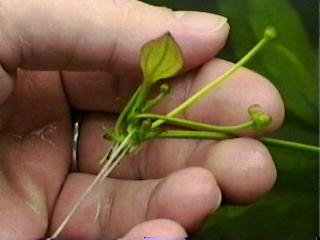Well, I was having a blast at the January meeting when someone
tipped me off that Manufacturer Minerals (in Renton) may be selling
reactive gravel...you know, the kind that leaches carbonates into the
water...under the label of aquarium gravel
. I suspect a few GSAS
members buy from MM, and judging from the business cards on the wall,
they supply several local fish stores as well (If you’re buying gravel
from an open bin at a store, you might be getting the same stuff), so
I’m passing on this information to the club and our local stores.
Calcium carbonate can indeed be found in some of MM’s so-called
aquarium gravel, in particular, the two Lapis Lustre
types. I
learned this personally this week when I tested a tank of this at pH
8.0, 4 degrees KH; the salesperson for MM even confirmed that Lapis
Lustre gravel contains some shell pieces! Great for Lake Tanganyika
Cichlids; bad for dwarf Apistogramma. However, they noted most of
their other small-grain gravel (such as Texas Grit) should be
inert.
If you want to be absolutely sure what you are getting is safe to just
dump in your tank, buy a reputable aquarium gravel such as
CongaRoc.(R) However, buying gravel in bulk need not be a
fearful experience. It is an excellent value when you are faced with
the alternative of having to pay for 200 pounds of
CongaRoc,(R) and the selection is always more natural
than many of the neon pink offerings. When in doubt (and you should
always be in doubt when trying new gravel), be careful:
absolutely surethat Lapis Lustre was safe for aquariums, but just didn’t realize shells are not considered safe! She said I was the first person to ever say anything about it.
fizz,as they react with the vinegar. This is a bad sign! (It may take a few minutes for the reaction to start, so let the dish sit for a while.)
I’m entering the above suggestions as my helpful hint
contest
submission, by the way, so you can’t use this one yourself! :)

My amazon swords have never sent up flower stalks, in the five years or so I’ve been keeping hi-tech plant tanks. Always wondered why, until a month ago when someone on the Aquatic Plants Discussion list mentioned the day length is directly correlated to flowering. Those buggers want to think it’s summer. And here I was giving my plants 10-12 hours a day of light (a nice precaution against algae plague). To make a long story short, I changed my tanks to 14-hour days, and you can guess the results.
Anyway, speaking of the January meeting, I wanted to take a little space to say this was an example of what GSAS can be... we had yet another good turnout--33, including three new members. There was a lot of activity during the freeform parts of the meeting, with plants and fish for sale. Several members (Anne Pace, Steve Avenell, Steve Ward and myself) ran the workshop, and everyone asked great questions. (No doubt we’re all building acrylic show tanks and not getting shocked by the light fixture.) We had five or so entries in the bowl show, won by Heather Candelaria’s monster guppy. (free plug: Heather is now the owner of Crystal Aquarium; stop by sometime & say hello, and don’t forget that GSAS member discount. She swears the prize-winning guppy is one of her personal fish from home, though!) The next bowl shows will be in March and April (especially April, when we’ll have a larger-than-normal crowd for the annual auction).
Meanwhile, both hours of our upcoming meeting will be entirely
devoted to the plant auction. If you’re new to the club, here’s how it
works: we’re purchasing several hundred dollars of wholesale plants
mailorder. The selection spans all types, from simple green hygro
through exotic crypts you’ve only read about. We never completely know
what we’ll have until we order it. (Got any special requests? Call
Anne; we can ask for it with the order!) We’ll try to describe each
item before it is auctioned (I spent a while pouring over books the
night before in past years), and then off it goes. A few have asked
how the pricing compares to retail; we don’t know! Every auction is
different. I can say that in past years some items sold for similar
amounts, but many for considerably less. Remember, though, that all
profit does go directly into the club (it’s actually our third biggest
source of income for the year), there will be many plants to choose
from, and you’ll be getting free advice
on keeping each plant
before you bid.
In keeping with the plant-themed meeting, we will have Siamese Algae Eaters (Crossocheilus siamensis) as our February Fish-of-the-Month. These cute relatives of the Flying Fox are the only known fish to eat red brush algae. Until recently, they were only available in the US through a small California retail store that imported them directly, but now it seems that the big wholesalers are catching on; they have been spotted in at least four local stores. And we’ll have a few of them free for members, plus some for bidding.
Finally, I’d like to end by thanking Kevin Ord for his two years of service on the GSAS board as Vice President. Kevin has resigned this month due to time commitments. Anne Pace will be Acting VP until we find a suitable scape...err, candidate.